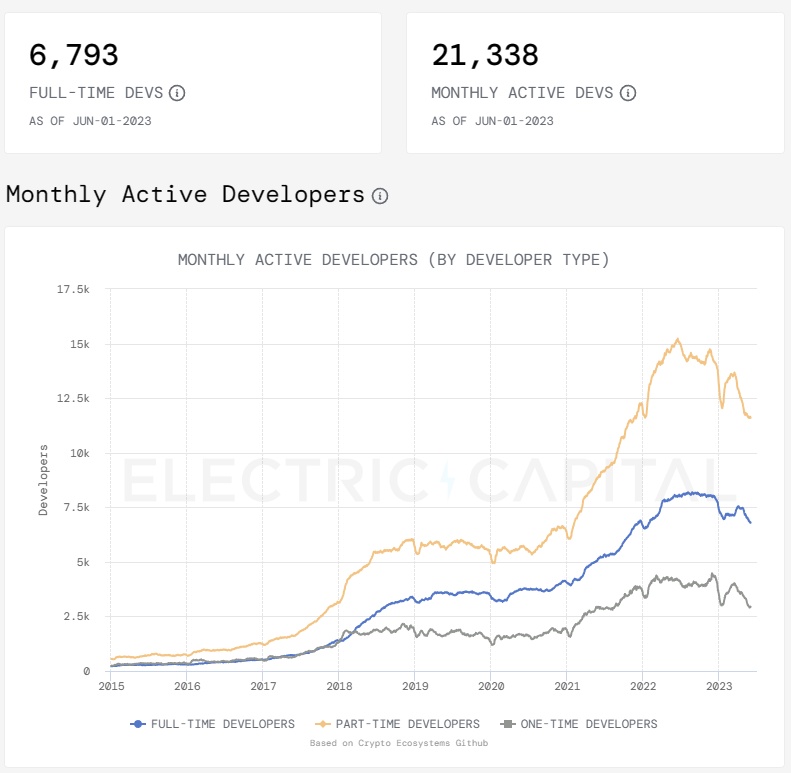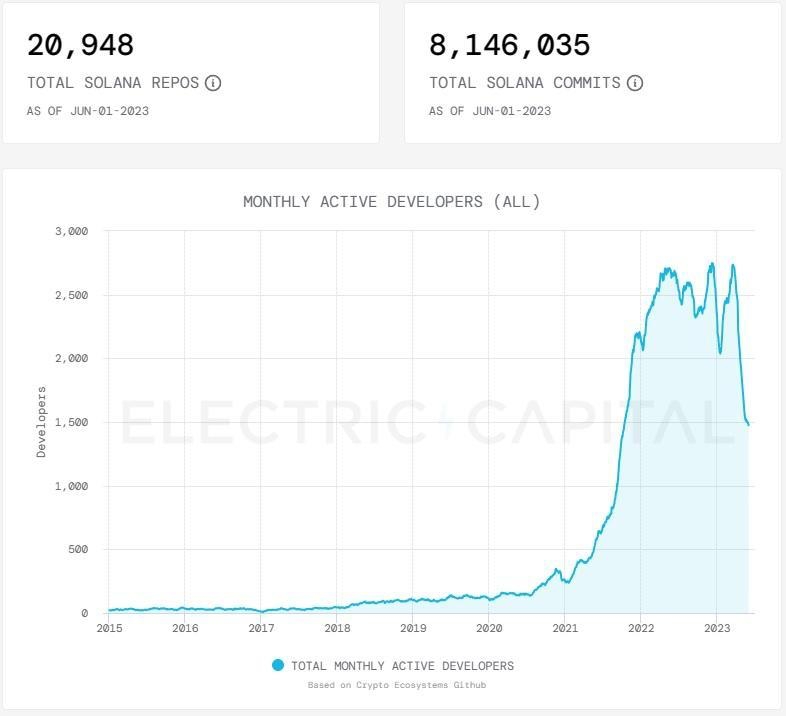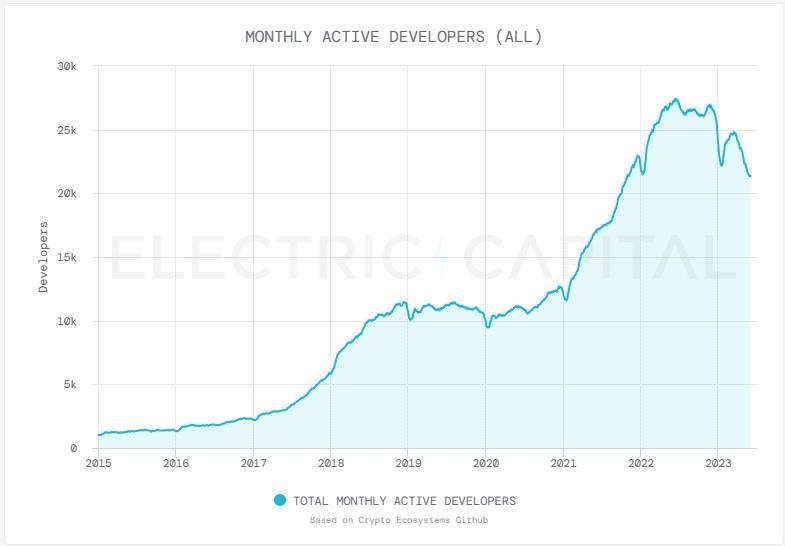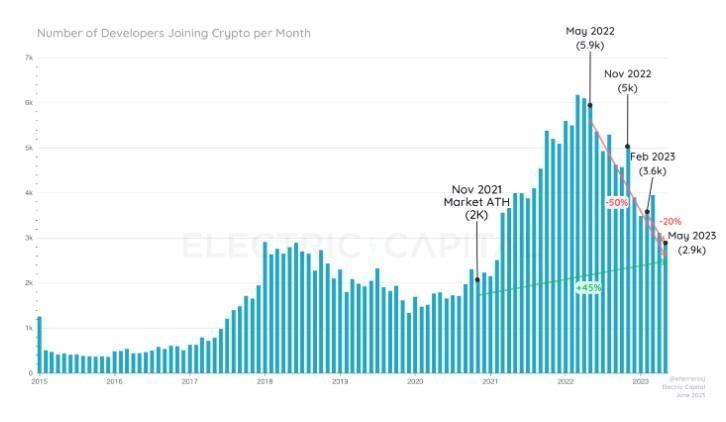
At Bitcoin Market Journal, we talk a lot about Daily Active Users (DAUs), and today, we’ll look at a different type of daily active user: the developer.
These are the people actively creating the blockchains we use. And they are just as important to growth as the end-user. Developer contributions directly impact crypto projects’ valuation, stability, and future.
In this article, we’re going to cover some of the central questions about DAD and its importance for investors:
- Who are daily active developers?
- What role do they play in blockchain ecosystems?
- What can crypto investors learn from a fundamental analysis of DAD metrics?
- How do the numbers and growth in daily active developers compare with that of daily active users regarding the overall value of the blockchain?
What are Daily Active Developers?
In simple terms, anyone actively involved in the regular development and maintenance of software in the blockchain space is called a daily active developer (DAD). The term can be used to refer to both individual developers and developer teams.
Electric Capital, compiler of the blockchain Developer Reports, looks at blockchain projects from the perspective of open-source commits to projects through platforms like Github. In other words, “active developers” are actively making and publishing changes to the blockchain’s code.
DADs come from diverse backgrounds and work in various capacities from all over the globe. We can broadly divide DADs into the following categories:
- Core Development Teams: The major cryptocurrencies have underlying blockchain protocols. The development and maintenance of these protocols are handled by teams of software developers, engineers, and data scientists. They are typically at the forefront of innovation in the blockchain space.
- Independent Contributors: Open-source development plays a crucial role in crypto. Outside core teams, thousands of independent developers and blockchain enthusiasts contribute their time and expertise to improve specific features or look for bug fixes in crypto projects, often voluntarily.
- Startups and Service Providers: Employees of blockchain-based startups and major companies also fall under the definition of daily active developers. They are usually involved in developing wallet services, dApps, smart contracts, and other crypto projects.
- Academic Researchers: Universities and research institutions also play a defining role in crypto. Various protocols and blockchains often start as research projects involving professors and students in an academic setting. For example, the Zcash crypto project started at Johns Hopkins University in 2013.

What Do Active Developers Do?
DADs are the brains behind blockchains. The blockchain ecosystem wouldn’t exist without the contributions of these developers. They are the ones who develop a blockchain protocol codebase from scratch, creating core functionalities and features.
You need active developers to test the code, fix bugs, optimize performance, improve security, patch out vulnerabilities, provide community support, offer technical assistance, create documentation, and conduct other forms of routine maintenance.
Everything in the crypto sphere relies on developer output, from protocol hard forks and upgrades to new smart contracts and dapps. Many senior DADs also work in crypto governance roles. Vitalik Buterin, the co-creator of Ethereum, is an excellent example of this.
Why Measure Daily Active Developers?
Crypto investors can glean valuable insights by closely examining the active developers behind a particular blockchain, project, or app. Here are some key performance indicators that tell us a blockchain project is getting traction:
- Developer Interest: When many developers consistently flock to a protocol, it is usually a good indicator of the project’s long-term viability. For example, due to its large number of developers, Ethereum is widely expected to overtake bitcoin at some point and become the world’s most valuable crypto – an event dubbed “the flippening.”
- Not surprisingly, Ethereum has consistently ranked at the top of the pile in daily active developers. At 5,946 in June 2023, it has nearly three times as many total developers as the next-highest project (Polkadot). High levels of developer interest are usually an indicator of the stability, maturity, and long-term viability of a blockchain project.
- Competitive Advantage: Skilled talent is needed in any IT field. The same is also true in crypto, especially during growth markets like 2022. There is extreme competition between various projects and companies for talented developers. If a project retains or increases its DAD counts, it is usually a sign of its advantage over its competitors.
- Again, Ethereum leaves all other blockchain projects in the dust here. The number of full-time developers at Ethereum has increased by 35% since 2021, indicating high activity levels across its ecosystem. More DADs improve a project’s ability to polish existing features, innovate, and gain a competitive advantage.
- Community Support and Engagement: Hype often plays a critical role in the early stages of a crypto project. It is useful to increase awareness among users and eventually develop a community around the project. Having many active developers, especially those who actively post on social media about the project, is a good sign.
- Constant interaction between users and developers can also contribute to the evolution of the project. It creates feedback loops that allow developers to find problems faster and figure out essential features for improved user experience.
DADs as an Investor Valuation Metric
The market price, token supply, token ownership, market cap, and daily active users are all valuable metrics for evaluating cryptocurrencies. However, these metrics are largely focused on the demand side of the equation.
A balanced assessment of crypto requires an in-depth understanding of the supply side as well. Supply metrics from a crypto POV include tokenomics, governance, security, bug hunting, smart contract support, cross-chain interoperability, and more.
All this requires massive volumes of software code. The number of available developers will determine a project’s ability to manage these responsibilities and complete critical tasks quickly.
In short, the contributions from DADs affect cryptocurrency valuation in the following ways:
- Project Health: The size of a project’s developer community can tell you a lot about what people in the know think about its viability and prospects. A higher number of DADs indicate that the crypto is healthy and vibrant.
- Stability and Security: The codebase of cryptocurrencies is constantly threatened by hackers and cybercriminals looking for flaws and vulnerabilities. Having more hands on deck for patching, bug fixing, and code reviews helps improve the stability and minimize the security risks of crypto.
- Innovation and Adaptability: Crypto projects must continue. They must constantly improve and evolve, adding new features and use cases to drive user adoption. A higher DAD count indicates that the crypto is more likely to succeed.
- Trust and Market Perception: For insights, seasoned investors and crypto users look at the developer community behind cryptos. A strong and active DAD community helps build trust and confidence in the project among users, investors, and other stakeholders. Solana, which has been under pressure due to its connection with FTX, is a good example.

The Relationship Between DADs and Users
The “network effect” is an economic concept where the value of a network increases exponentially as more people use it. It has played a critical role in many industries in recent years, including social media and e-commerce platforms.
In crypto, the rise of most tokens can be attributed to the network effect. It involves a close relationship between developers and users through several dynamic stages:
- The User Adoption Stage: The process starts with creating the initial codebase of the project. The development team then markets the project among potential users by publishing whitepapers, social media, airdrops, influencers, and bounty programs.
- Community engagement is critical here. Developers often engage in forum discussions, conduct AMA sessions, and answer queries on social media handles to interact with their audience and increase awareness about the project.
- Community Building: In the second stage, the continued interaction between developers and users helps amplify the network effect in several ways. It increases trust in the project and helps it gain credibility. High engagement levels eventually lead to strong communities that market the crypto to other potential users.
- Feedback Loops and Value Generation: When developers constantly interact with users, the result is a mutually beneficial exchange of information. Support from developers helps the project become more user-friendly, increasing its adoption rate.
- Developers also gain valuable feedback and constructive criticism from daily users of the crypto/project. They can use these insights to improve the codebase further, identify potential security threats early, and generate more user value.
When a team consistently delivers exciting new features, quality-of-life improvements, and bug fixes to a software project, you will generally see a steady uptick in active users. Having more DADs can help crypto attract more daily active users.

Bitcoin, NEAR, Ethereum, and BNB are all on top of our list of blockchains with the most daily active users. These are also crypto ecosystems with hundreds of full-time developers, according to the latest figures from DeveloperReport.com.
Emerging Ecosystems and Small Chains
Since 2020, the crypto market has launched hundreds of new blockchain projects, including Layer-1 protocols. While most of these have faded into obscurity, several notable exceptions exist.
From a daily active developer count perspective, three stand out as of this writing: Sui, Aptos, and Osmosis. The Sui Network recorded a 444% increase in its full-time developer count in 2023, coinciding with the launch of its token in April 2023.
Aptos has been around since early 2022, increasing its DAD count by 191%. Launched in June 2021, Osmosis has increased its total developer count by 296% over two years. All three projects have between 200 and 300 total developers as of this writing.
To put things in perspective, other established blockchains have clocked a decline in developer counts since the beginning of the bear market in 2022 – examples include Algorand (-63%), Avalanche (-57%), and NEAR (-51%).
Aptos and Sui have received millions of dollars in funding from major investors like a16z, Binance Labs, Accel Partners, Tiger Global, and Multicoin Capital. Similarly, Osmosis Labs counts Paradigm and Ethereal Ventures among its main backers.
In market cap, Aptos is ranked 36, Sui is 88, and Osmosis is much lower at 157. And yet, these emerging blockchain ecosystems manage to attract both investors and developers, indicating considerable future growth potential.
They highlight the importance of looking beyond price and market cap when researching new crypto investments. Factors like investor funding activity and rising developer counts often hint at the future growth potential of emerging ecosystems.

Investor Takeaway
The spectacular market crash in 2022 resulted in $2 trillion in crypto losses. Major tokens like Bitcoin and Ethereum lost over 60% of their peak valuation. And yet, we only saw a marginal decrease in daily active developer counts between 2022 and 2023.
More crucially, the developers contributing over 80% of the code commits for years are still actively involved in crypto. Most developers are in crypto for the long haul, boding well for the industry's long-term growth.
As crypto winter leads to spring, this is another reason investors need to include DADs as a metric for fundamental research in crypto.
Developers are the architects of crypto’s fundamental infrastructure. They build and maintain the codebase, interact with users, and help in community growth. Development and innovation are necessary for growth in crypto, and developers are the bellwether for both.
Subscribe to Bitcoin Market Journal to learn about the metrics that make blockchain and crypto the most valuable assets.

